Hurricane Katrina: Engineering Failures and Catastrophic Consequences
VerifiedAdded on 2023/04/07
|8
|1887
|54
Report
AI Summary
This report provides a comprehensive overview of Hurricane Katrina, examining its origins, impact, and the catastrophic consequences of engineering failures. It details the classification of hurricanes, focusing on Hurricane Katrina's devastating effects on Florida, Louisiana, and particularly New Orleans in August 2005. The report highlights the failures in the levee and floodwall systems, including faulty designs, inadequate maintenance, and underestimation of soil strength, which led to widespread flooding and loss of life. The analysis covers the specific breaches in the Industrial Canal, 17th Street Canal, and London Avenue Canal, and the roles of the United States Army Corps of Engineers and local levee boards. It also discusses the engineering oversights, such as the water-filled gaps and the underestimation of peat layers, that contributed to the structural failures. The study concludes by emphasizing the importance of engineering responsibility and the need for robust designs to prevent such disasters in the future.
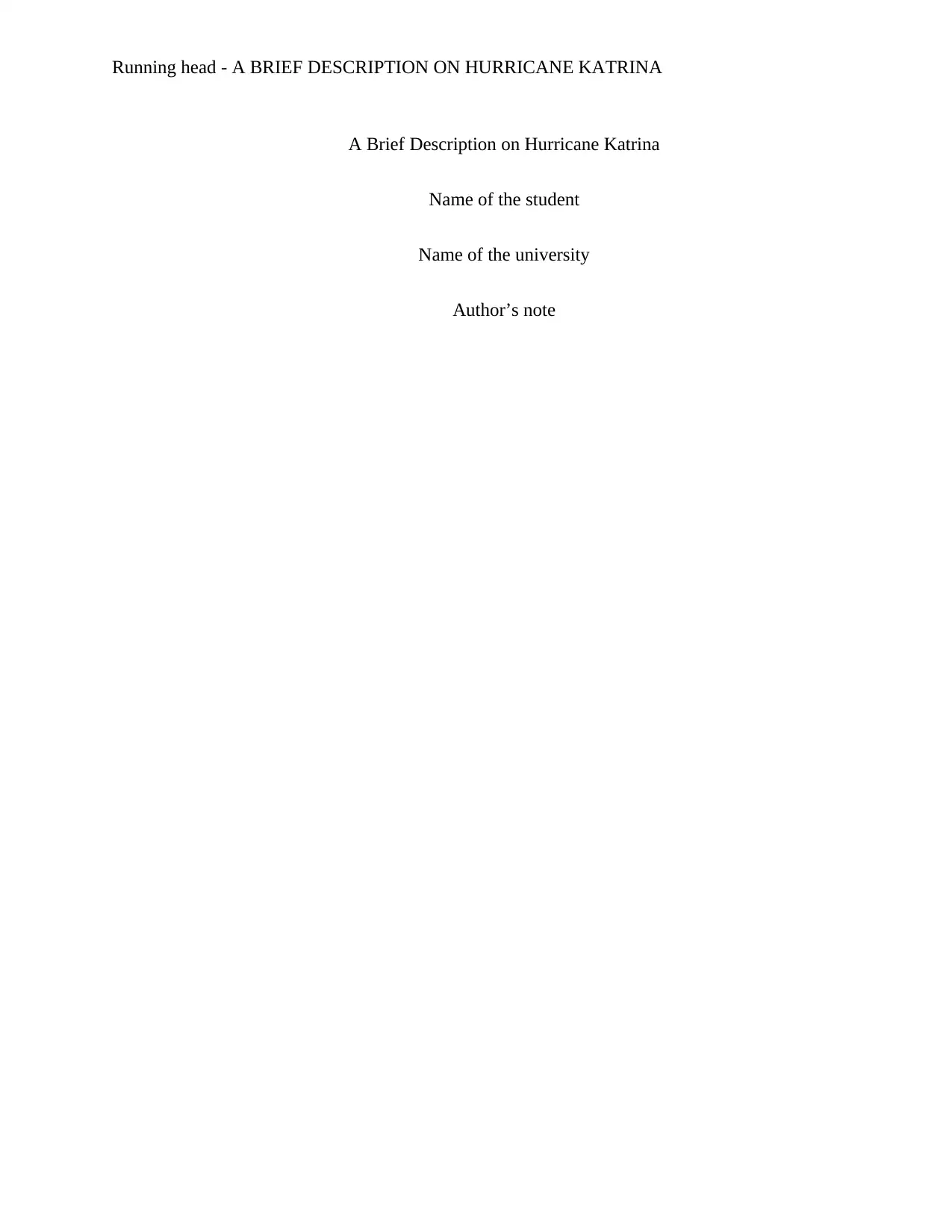
Running head - A BRIEF DESCRIPTION ON HURRICANE KATRINA
A Brief Description on Hurricane Katrina
Name of the student
Name of the university
Author’s note
A Brief Description on Hurricane Katrina
Name of the student
Name of the university
Author’s note
Paraphrase This Document
Need a fresh take? Get an instant paraphrase of this document with our AI Paraphraser
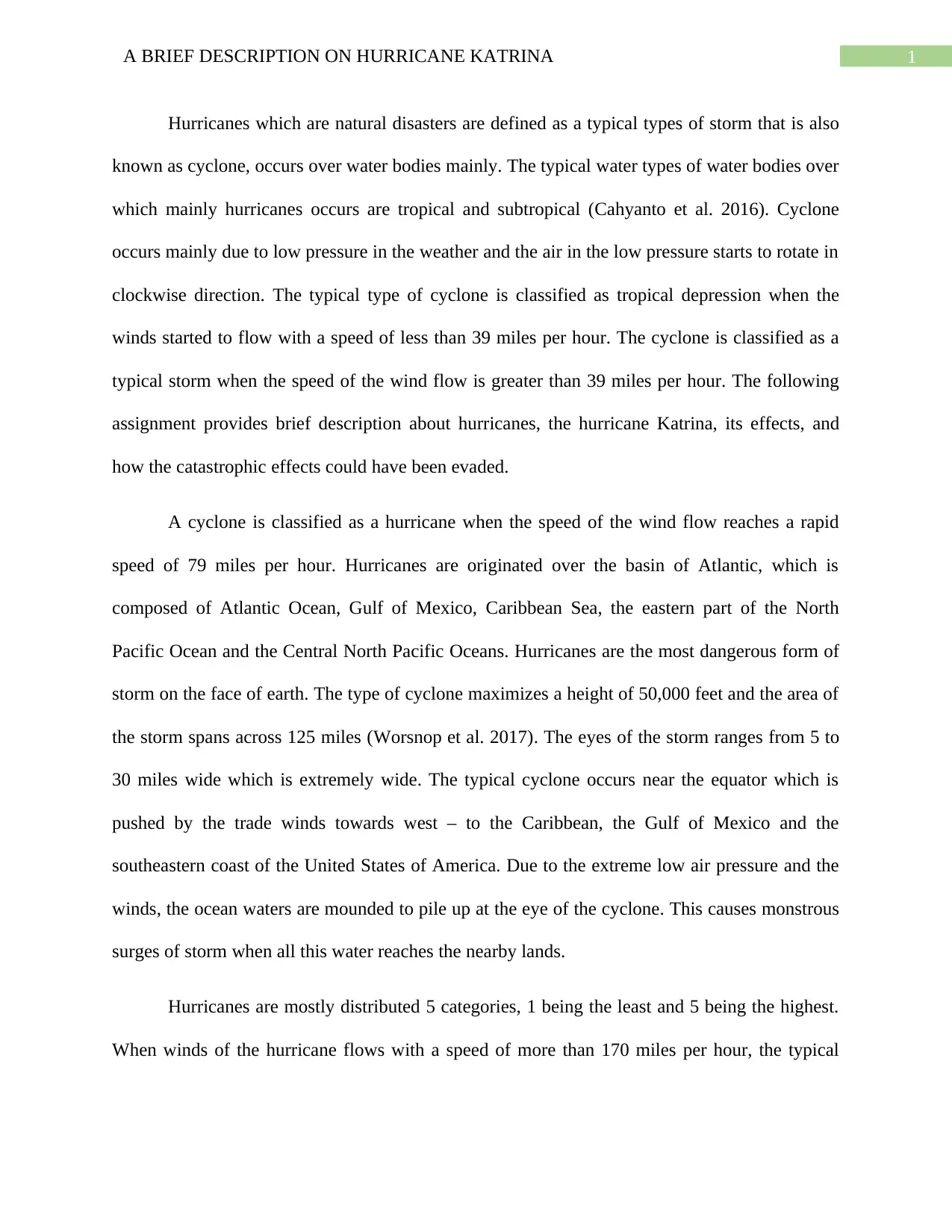
1A BRIEF DESCRIPTION ON HURRICANE KATRINA
Hurricanes which are natural disasters are defined as a typical types of storm that is also
known as cyclone, occurs over water bodies mainly. The typical water types of water bodies over
which mainly hurricanes occurs are tropical and subtropical (Cahyanto et al. 2016). Cyclone
occurs mainly due to low pressure in the weather and the air in the low pressure starts to rotate in
clockwise direction. The typical type of cyclone is classified as tropical depression when the
winds started to flow with a speed of less than 39 miles per hour. The cyclone is classified as a
typical storm when the speed of the wind flow is greater than 39 miles per hour. The following
assignment provides brief description about hurricanes, the hurricane Katrina, its effects, and
how the catastrophic effects could have been evaded.
A cyclone is classified as a hurricane when the speed of the wind flow reaches a rapid
speed of 79 miles per hour. Hurricanes are originated over the basin of Atlantic, which is
composed of Atlantic Ocean, Gulf of Mexico, Caribbean Sea, the eastern part of the North
Pacific Ocean and the Central North Pacific Oceans. Hurricanes are the most dangerous form of
storm on the face of earth. The type of cyclone maximizes a height of 50,000 feet and the area of
the storm spans across 125 miles (Worsnop et al. 2017). The eyes of the storm ranges from 5 to
30 miles wide which is extremely wide. The typical cyclone occurs near the equator which is
pushed by the trade winds towards west – to the Caribbean, the Gulf of Mexico and the
southeastern coast of the United States of America. Due to the extreme low air pressure and the
winds, the ocean waters are mounded to pile up at the eye of the cyclone. This causes monstrous
surges of storm when all this water reaches the nearby lands.
Hurricanes are mostly distributed 5 categories, 1 being the least and 5 being the highest.
When winds of the hurricane flows with a speed of more than 170 miles per hour, the typical
Hurricanes which are natural disasters are defined as a typical types of storm that is also
known as cyclone, occurs over water bodies mainly. The typical water types of water bodies over
which mainly hurricanes occurs are tropical and subtropical (Cahyanto et al. 2016). Cyclone
occurs mainly due to low pressure in the weather and the air in the low pressure starts to rotate in
clockwise direction. The typical type of cyclone is classified as tropical depression when the
winds started to flow with a speed of less than 39 miles per hour. The cyclone is classified as a
typical storm when the speed of the wind flow is greater than 39 miles per hour. The following
assignment provides brief description about hurricanes, the hurricane Katrina, its effects, and
how the catastrophic effects could have been evaded.
A cyclone is classified as a hurricane when the speed of the wind flow reaches a rapid
speed of 79 miles per hour. Hurricanes are originated over the basin of Atlantic, which is
composed of Atlantic Ocean, Gulf of Mexico, Caribbean Sea, the eastern part of the North
Pacific Ocean and the Central North Pacific Oceans. Hurricanes are the most dangerous form of
storm on the face of earth. The type of cyclone maximizes a height of 50,000 feet and the area of
the storm spans across 125 miles (Worsnop et al. 2017). The eyes of the storm ranges from 5 to
30 miles wide which is extremely wide. The typical cyclone occurs near the equator which is
pushed by the trade winds towards west – to the Caribbean, the Gulf of Mexico and the
southeastern coast of the United States of America. Due to the extreme low air pressure and the
winds, the ocean waters are mounded to pile up at the eye of the cyclone. This causes monstrous
surges of storm when all this water reaches the nearby lands.
Hurricanes are mostly distributed 5 categories, 1 being the least and 5 being the highest.
When winds of the hurricane flows with a speed of more than 170 miles per hour, the typical
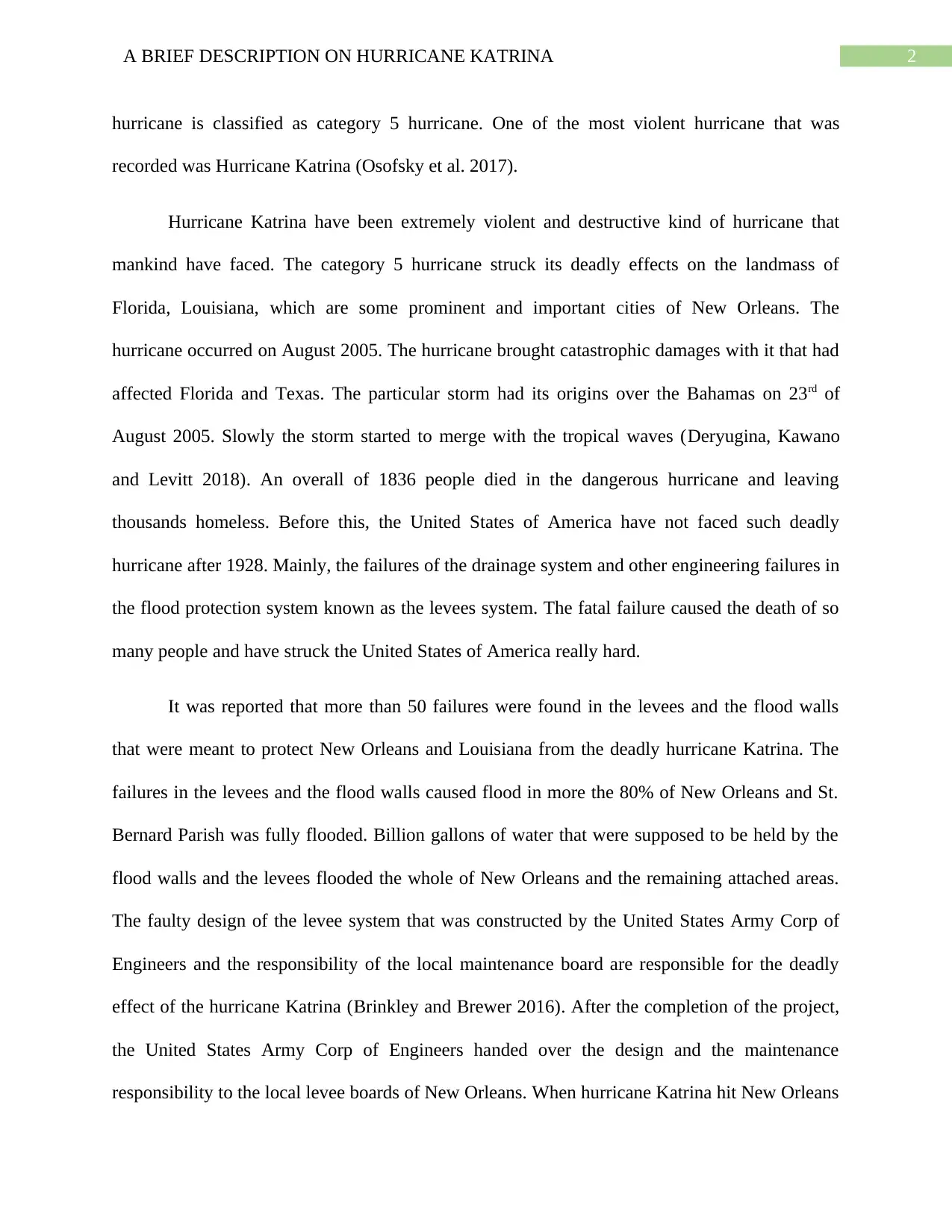
2A BRIEF DESCRIPTION ON HURRICANE KATRINA
hurricane is classified as category 5 hurricane. One of the most violent hurricane that was
recorded was Hurricane Katrina (Osofsky et al. 2017).
Hurricane Katrina have been extremely violent and destructive kind of hurricane that
mankind have faced. The category 5 hurricane struck its deadly effects on the landmass of
Florida, Louisiana, which are some prominent and important cities of New Orleans. The
hurricane occurred on August 2005. The hurricane brought catastrophic damages with it that had
affected Florida and Texas. The particular storm had its origins over the Bahamas on 23rd of
August 2005. Slowly the storm started to merge with the tropical waves (Deryugina, Kawano
and Levitt 2018). An overall of 1836 people died in the dangerous hurricane and leaving
thousands homeless. Before this, the United States of America have not faced such deadly
hurricane after 1928. Mainly, the failures of the drainage system and other engineering failures in
the flood protection system known as the levees system. The fatal failure caused the death of so
many people and have struck the United States of America really hard.
It was reported that more than 50 failures were found in the levees and the flood walls
that were meant to protect New Orleans and Louisiana from the deadly hurricane Katrina. The
failures in the levees and the flood walls caused flood in more the 80% of New Orleans and St.
Bernard Parish was fully flooded. Billion gallons of water that were supposed to be held by the
flood walls and the levees flooded the whole of New Orleans and the remaining attached areas.
The faulty design of the levee system that was constructed by the United States Army Corp of
Engineers and the responsibility of the local maintenance board are responsible for the deadly
effect of the hurricane Katrina (Brinkley and Brewer 2016). After the completion of the project,
the United States Army Corp of Engineers handed over the design and the maintenance
responsibility to the local levee boards of New Orleans. When hurricane Katrina hit New Orleans
hurricane is classified as category 5 hurricane. One of the most violent hurricane that was
recorded was Hurricane Katrina (Osofsky et al. 2017).
Hurricane Katrina have been extremely violent and destructive kind of hurricane that
mankind have faced. The category 5 hurricane struck its deadly effects on the landmass of
Florida, Louisiana, which are some prominent and important cities of New Orleans. The
hurricane occurred on August 2005. The hurricane brought catastrophic damages with it that had
affected Florida and Texas. The particular storm had its origins over the Bahamas on 23rd of
August 2005. Slowly the storm started to merge with the tropical waves (Deryugina, Kawano
and Levitt 2018). An overall of 1836 people died in the dangerous hurricane and leaving
thousands homeless. Before this, the United States of America have not faced such deadly
hurricane after 1928. Mainly, the failures of the drainage system and other engineering failures in
the flood protection system known as the levees system. The fatal failure caused the death of so
many people and have struck the United States of America really hard.
It was reported that more than 50 failures were found in the levees and the flood walls
that were meant to protect New Orleans and Louisiana from the deadly hurricane Katrina. The
failures in the levees and the flood walls caused flood in more the 80% of New Orleans and St.
Bernard Parish was fully flooded. Billion gallons of water that were supposed to be held by the
flood walls and the levees flooded the whole of New Orleans and the remaining attached areas.
The faulty design of the levee system that was constructed by the United States Army Corp of
Engineers and the responsibility of the local maintenance board are responsible for the deadly
effect of the hurricane Katrina (Brinkley and Brewer 2016). After the completion of the project,
the United States Army Corp of Engineers handed over the design and the maintenance
responsibility to the local levee boards of New Orleans. When hurricane Katrina hit New Orleans
⊘ This is a preview!⊘
Do you want full access?
Subscribe today to unlock all pages.

Trusted by 1+ million students worldwide
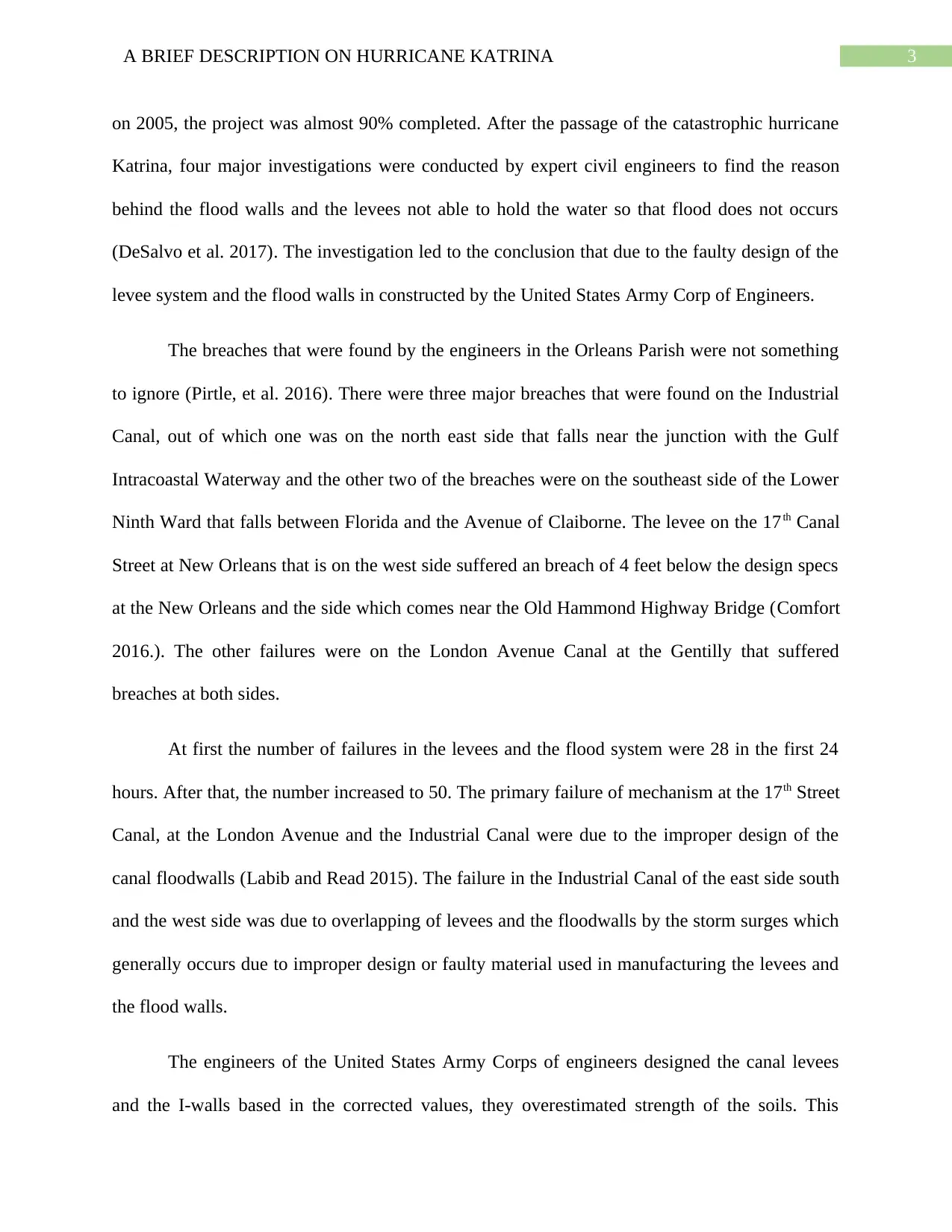
3A BRIEF DESCRIPTION ON HURRICANE KATRINA
on 2005, the project was almost 90% completed. After the passage of the catastrophic hurricane
Katrina, four major investigations were conducted by expert civil engineers to find the reason
behind the flood walls and the levees not able to hold the water so that flood does not occurs
(DeSalvo et al. 2017). The investigation led to the conclusion that due to the faulty design of the
levee system and the flood walls in constructed by the United States Army Corp of Engineers.
The breaches that were found by the engineers in the Orleans Parish were not something
to ignore (Pirtle, et al. 2016). There were three major breaches that were found on the Industrial
Canal, out of which one was on the north east side that falls near the junction with the Gulf
Intracoastal Waterway and the other two of the breaches were on the southeast side of the Lower
Ninth Ward that falls between Florida and the Avenue of Claiborne. The levee on the 17th Canal
Street at New Orleans that is on the west side suffered an breach of 4 feet below the design specs
at the New Orleans and the side which comes near the Old Hammond Highway Bridge (Comfort
2016.). The other failures were on the London Avenue Canal at the Gentilly that suffered
breaches at both sides.
At first the number of failures in the levees and the flood system were 28 in the first 24
hours. After that, the number increased to 50. The primary failure of mechanism at the 17th Street
Canal, at the London Avenue and the Industrial Canal were due to the improper design of the
canal floodwalls (Labib and Read 2015). The failure in the Industrial Canal of the east side south
and the west side was due to overlapping of levees and the floodwalls by the storm surges which
generally occurs due to improper design or faulty material used in manufacturing the levees and
the flood walls.
The engineers of the United States Army Corps of engineers designed the canal levees
and the I-walls based in the corrected values, they overestimated strength of the soils. This
on 2005, the project was almost 90% completed. After the passage of the catastrophic hurricane
Katrina, four major investigations were conducted by expert civil engineers to find the reason
behind the flood walls and the levees not able to hold the water so that flood does not occurs
(DeSalvo et al. 2017). The investigation led to the conclusion that due to the faulty design of the
levee system and the flood walls in constructed by the United States Army Corp of Engineers.
The breaches that were found by the engineers in the Orleans Parish were not something
to ignore (Pirtle, et al. 2016). There were three major breaches that were found on the Industrial
Canal, out of which one was on the north east side that falls near the junction with the Gulf
Intracoastal Waterway and the other two of the breaches were on the southeast side of the Lower
Ninth Ward that falls between Florida and the Avenue of Claiborne. The levee on the 17th Canal
Street at New Orleans that is on the west side suffered an breach of 4 feet below the design specs
at the New Orleans and the side which comes near the Old Hammond Highway Bridge (Comfort
2016.). The other failures were on the London Avenue Canal at the Gentilly that suffered
breaches at both sides.
At first the number of failures in the levees and the flood system were 28 in the first 24
hours. After that, the number increased to 50. The primary failure of mechanism at the 17th Street
Canal, at the London Avenue and the Industrial Canal were due to the improper design of the
canal floodwalls (Labib and Read 2015). The failure in the Industrial Canal of the east side south
and the west side was due to overlapping of levees and the floodwalls by the storm surges which
generally occurs due to improper design or faulty material used in manufacturing the levees and
the flood walls.
The engineers of the United States Army Corps of engineers designed the canal levees
and the I-walls based in the corrected values, they overestimated strength of the soils. This
Paraphrase This Document
Need a fresh take? Get an instant paraphrase of this document with our AI Paraphraser
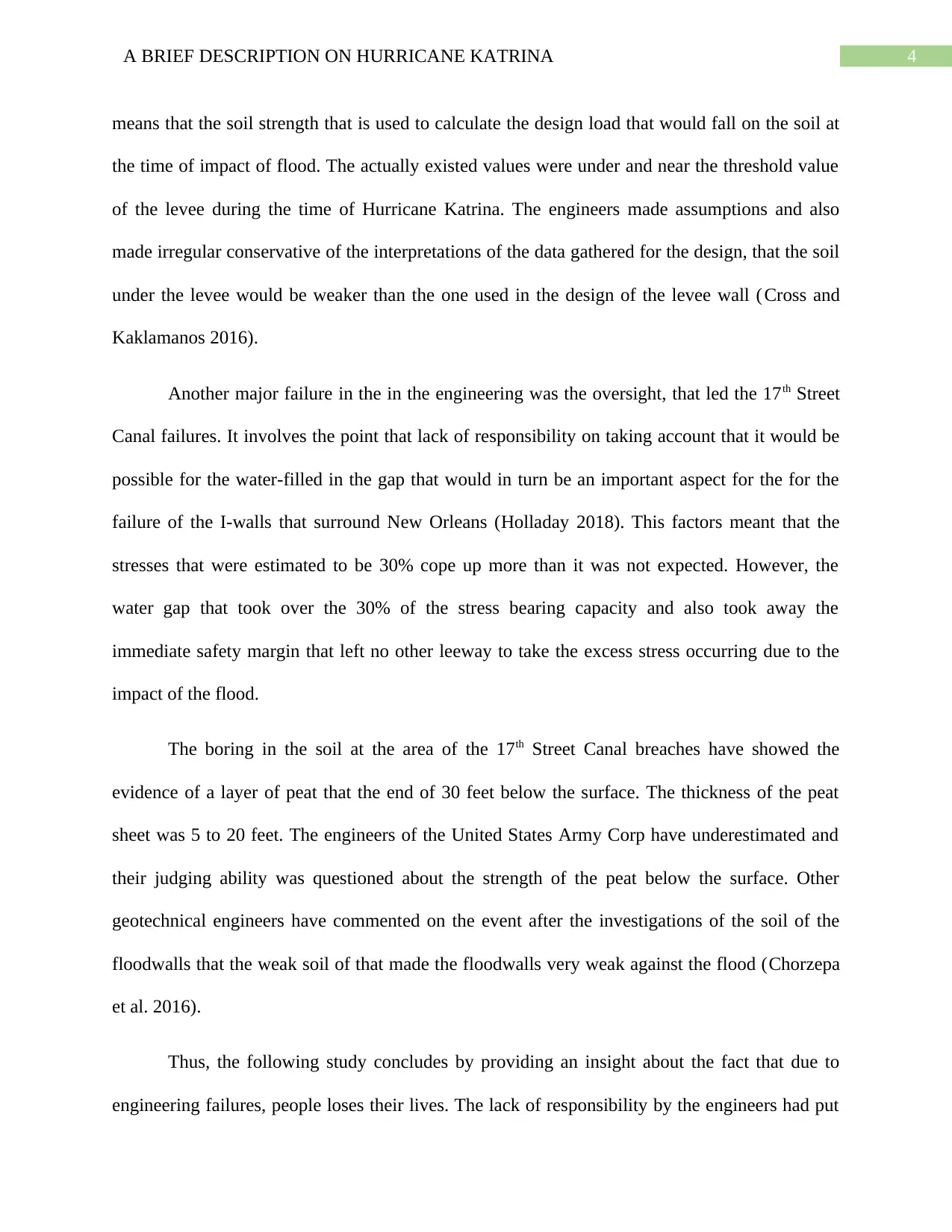
4A BRIEF DESCRIPTION ON HURRICANE KATRINA
means that the soil strength that is used to calculate the design load that would fall on the soil at
the time of impact of flood. The actually existed values were under and near the threshold value
of the levee during the time of Hurricane Katrina. The engineers made assumptions and also
made irregular conservative of the interpretations of the data gathered for the design, that the soil
under the levee would be weaker than the one used in the design of the levee wall (Cross and
Kaklamanos 2016).
Another major failure in the in the engineering was the oversight, that led the 17th Street
Canal failures. It involves the point that lack of responsibility on taking account that it would be
possible for the water-filled in the gap that would in turn be an important aspect for the for the
failure of the I-walls that surround New Orleans (Holladay 2018). This factors meant that the
stresses that were estimated to be 30% cope up more than it was not expected. However, the
water gap that took over the 30% of the stress bearing capacity and also took away the
immediate safety margin that left no other leeway to take the excess stress occurring due to the
impact of the flood.
The boring in the soil at the area of the 17th Street Canal breaches have showed the
evidence of a layer of peat that the end of 30 feet below the surface. The thickness of the peat
sheet was 5 to 20 feet. The engineers of the United States Army Corp have underestimated and
their judging ability was questioned about the strength of the peat below the surface. Other
geotechnical engineers have commented on the event after the investigations of the soil of the
floodwalls that the weak soil of that made the floodwalls very weak against the flood (Chorzepa
et al. 2016).
Thus, the following study concludes by providing an insight about the fact that due to
engineering failures, people loses their lives. The lack of responsibility by the engineers had put
means that the soil strength that is used to calculate the design load that would fall on the soil at
the time of impact of flood. The actually existed values were under and near the threshold value
of the levee during the time of Hurricane Katrina. The engineers made assumptions and also
made irregular conservative of the interpretations of the data gathered for the design, that the soil
under the levee would be weaker than the one used in the design of the levee wall (Cross and
Kaklamanos 2016).
Another major failure in the in the engineering was the oversight, that led the 17th Street
Canal failures. It involves the point that lack of responsibility on taking account that it would be
possible for the water-filled in the gap that would in turn be an important aspect for the for the
failure of the I-walls that surround New Orleans (Holladay 2018). This factors meant that the
stresses that were estimated to be 30% cope up more than it was not expected. However, the
water gap that took over the 30% of the stress bearing capacity and also took away the
immediate safety margin that left no other leeway to take the excess stress occurring due to the
impact of the flood.
The boring in the soil at the area of the 17th Street Canal breaches have showed the
evidence of a layer of peat that the end of 30 feet below the surface. The thickness of the peat
sheet was 5 to 20 feet. The engineers of the United States Army Corp have underestimated and
their judging ability was questioned about the strength of the peat below the surface. Other
geotechnical engineers have commented on the event after the investigations of the soil of the
floodwalls that the weak soil of that made the floodwalls very weak against the flood (Chorzepa
et al. 2016).
Thus, the following study concludes by providing an insight about the fact that due to
engineering failures, people loses their lives. The lack of responsibility by the engineers had put
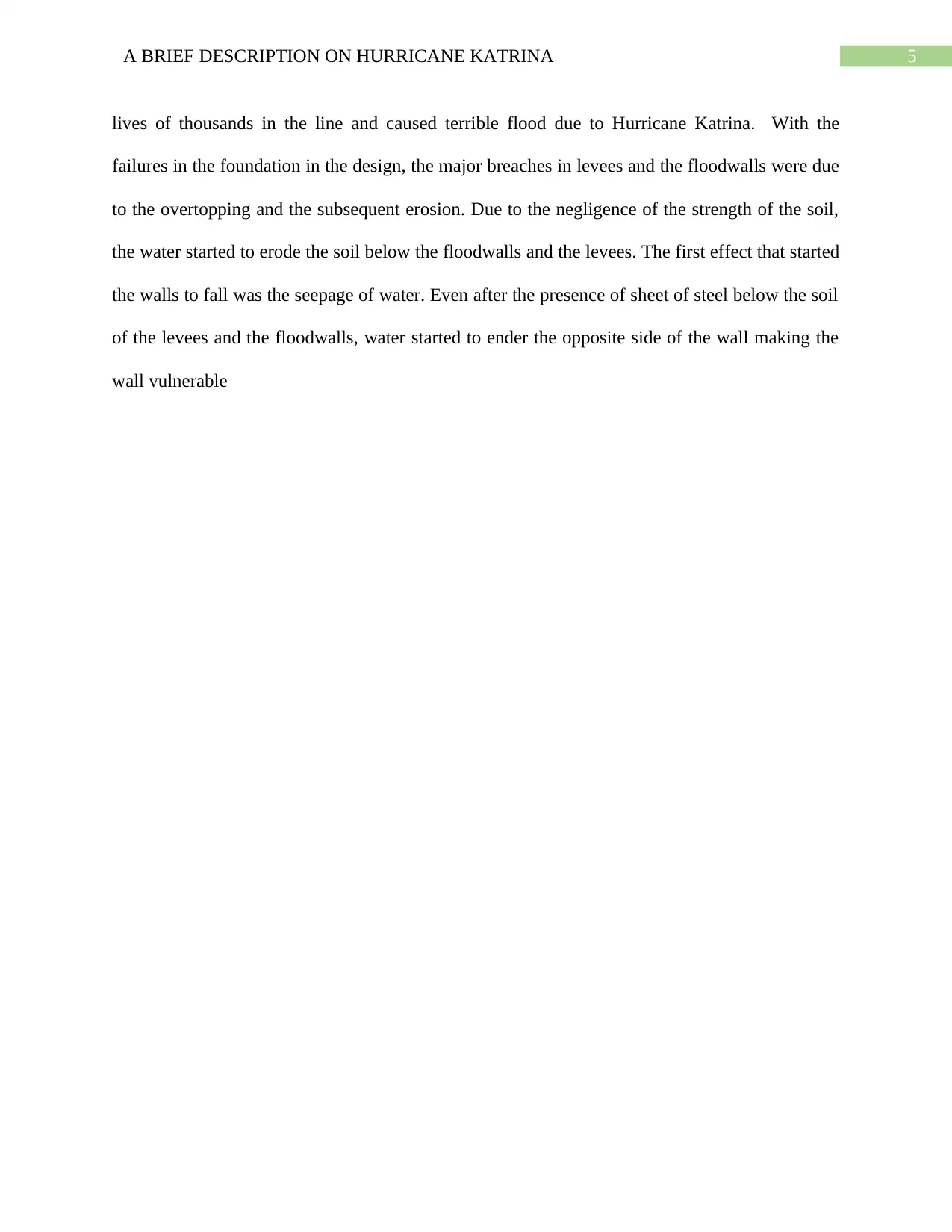
5A BRIEF DESCRIPTION ON HURRICANE KATRINA
lives of thousands in the line and caused terrible flood due to Hurricane Katrina. With the
failures in the foundation in the design, the major breaches in levees and the floodwalls were due
to the overtopping and the subsequent erosion. Due to the negligence of the strength of the soil,
the water started to erode the soil below the floodwalls and the levees. The first effect that started
the walls to fall was the seepage of water. Even after the presence of sheet of steel below the soil
of the levees and the floodwalls, water started to ender the opposite side of the wall making the
wall vulnerable
lives of thousands in the line and caused terrible flood due to Hurricane Katrina. With the
failures in the foundation in the design, the major breaches in levees and the floodwalls were due
to the overtopping and the subsequent erosion. Due to the negligence of the strength of the soil,
the water started to erode the soil below the floodwalls and the levees. The first effect that started
the walls to fall was the seepage of water. Even after the presence of sheet of steel below the soil
of the levees and the floodwalls, water started to ender the opposite side of the wall making the
wall vulnerable
⊘ This is a preview!⊘
Do you want full access?
Subscribe today to unlock all pages.

Trusted by 1+ million students worldwide
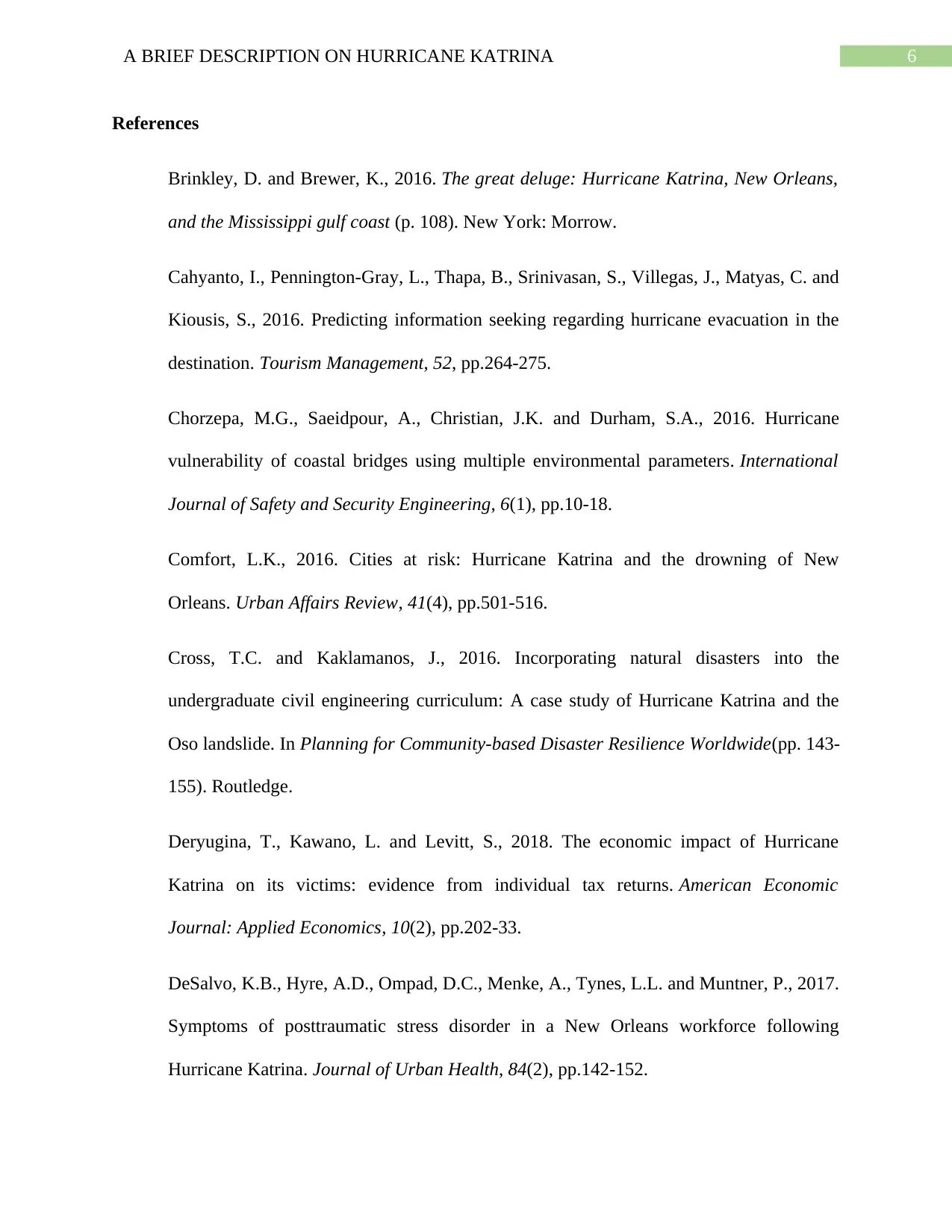
6A BRIEF DESCRIPTION ON HURRICANE KATRINA
References
Brinkley, D. and Brewer, K., 2016. The great deluge: Hurricane Katrina, New Orleans,
and the Mississippi gulf coast (p. 108). New York: Morrow.
Cahyanto, I., Pennington-Gray, L., Thapa, B., Srinivasan, S., Villegas, J., Matyas, C. and
Kiousis, S., 2016. Predicting information seeking regarding hurricane evacuation in the
destination. Tourism Management, 52, pp.264-275.
Chorzepa, M.G., Saeidpour, A., Christian, J.K. and Durham, S.A., 2016. Hurricane
vulnerability of coastal bridges using multiple environmental parameters. International
Journal of Safety and Security Engineering, 6(1), pp.10-18.
Comfort, L.K., 2016. Cities at risk: Hurricane Katrina and the drowning of New
Orleans. Urban Affairs Review, 41(4), pp.501-516.
Cross, T.C. and Kaklamanos, J., 2016. Incorporating natural disasters into the
undergraduate civil engineering curriculum: A case study of Hurricane Katrina and the
Oso landslide. In Planning for Community-based Disaster Resilience Worldwide(pp. 143-
155). Routledge.
Deryugina, T., Kawano, L. and Levitt, S., 2018. The economic impact of Hurricane
Katrina on its victims: evidence from individual tax returns. American Economic
Journal: Applied Economics, 10(2), pp.202-33.
DeSalvo, K.B., Hyre, A.D., Ompad, D.C., Menke, A., Tynes, L.L. and Muntner, P., 2017.
Symptoms of posttraumatic stress disorder in a New Orleans workforce following
Hurricane Katrina. Journal of Urban Health, 84(2), pp.142-152.
References
Brinkley, D. and Brewer, K., 2016. The great deluge: Hurricane Katrina, New Orleans,
and the Mississippi gulf coast (p. 108). New York: Morrow.
Cahyanto, I., Pennington-Gray, L., Thapa, B., Srinivasan, S., Villegas, J., Matyas, C. and
Kiousis, S., 2016. Predicting information seeking regarding hurricane evacuation in the
destination. Tourism Management, 52, pp.264-275.
Chorzepa, M.G., Saeidpour, A., Christian, J.K. and Durham, S.A., 2016. Hurricane
vulnerability of coastal bridges using multiple environmental parameters. International
Journal of Safety and Security Engineering, 6(1), pp.10-18.
Comfort, L.K., 2016. Cities at risk: Hurricane Katrina and the drowning of New
Orleans. Urban Affairs Review, 41(4), pp.501-516.
Cross, T.C. and Kaklamanos, J., 2016. Incorporating natural disasters into the
undergraduate civil engineering curriculum: A case study of Hurricane Katrina and the
Oso landslide. In Planning for Community-based Disaster Resilience Worldwide(pp. 143-
155). Routledge.
Deryugina, T., Kawano, L. and Levitt, S., 2018. The economic impact of Hurricane
Katrina on its victims: evidence from individual tax returns. American Economic
Journal: Applied Economics, 10(2), pp.202-33.
DeSalvo, K.B., Hyre, A.D., Ompad, D.C., Menke, A., Tynes, L.L. and Muntner, P., 2017.
Symptoms of posttraumatic stress disorder in a New Orleans workforce following
Hurricane Katrina. Journal of Urban Health, 84(2), pp.142-152.
Paraphrase This Document
Need a fresh take? Get an instant paraphrase of this document with our AI Paraphraser
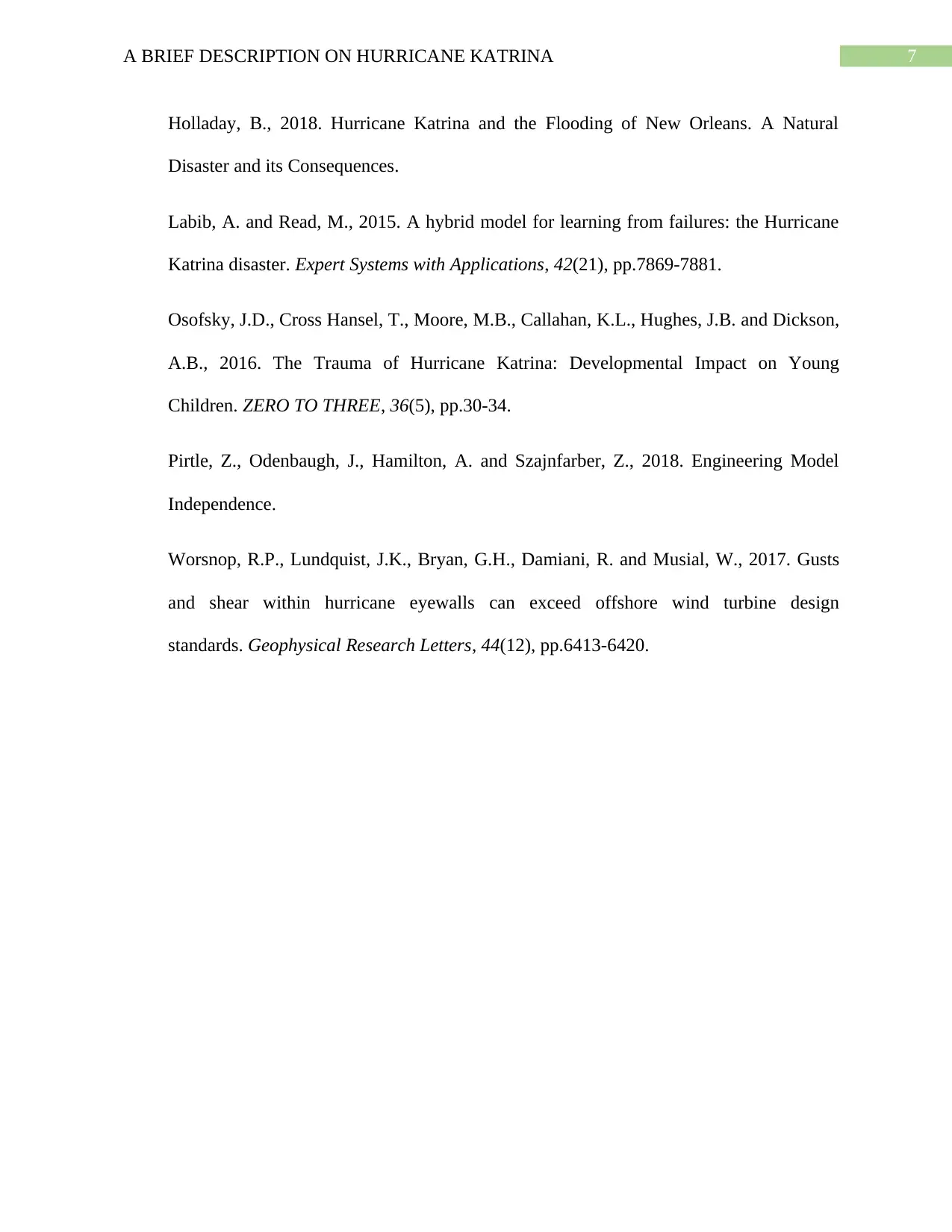
7A BRIEF DESCRIPTION ON HURRICANE KATRINA
Holladay, B., 2018. Hurricane Katrina and the Flooding of New Orleans. A Natural
Disaster and its Consequences.
Labib, A. and Read, M., 2015. A hybrid model for learning from failures: the Hurricane
Katrina disaster. Expert Systems with Applications, 42(21), pp.7869-7881.
Osofsky, J.D., Cross Hansel, T., Moore, M.B., Callahan, K.L., Hughes, J.B. and Dickson,
A.B., 2016. The Trauma of Hurricane Katrina: Developmental Impact on Young
Children. ZERO TO THREE, 36(5), pp.30-34.
Pirtle, Z., Odenbaugh, J., Hamilton, A. and Szajnfarber, Z., 2018. Engineering Model
Independence.
Worsnop, R.P., Lundquist, J.K., Bryan, G.H., Damiani, R. and Musial, W., 2017. Gusts
and shear within hurricane eyewalls can exceed offshore wind turbine design
standards. Geophysical Research Letters, 44(12), pp.6413-6420.
Holladay, B., 2018. Hurricane Katrina and the Flooding of New Orleans. A Natural
Disaster and its Consequences.
Labib, A. and Read, M., 2015. A hybrid model for learning from failures: the Hurricane
Katrina disaster. Expert Systems with Applications, 42(21), pp.7869-7881.
Osofsky, J.D., Cross Hansel, T., Moore, M.B., Callahan, K.L., Hughes, J.B. and Dickson,
A.B., 2016. The Trauma of Hurricane Katrina: Developmental Impact on Young
Children. ZERO TO THREE, 36(5), pp.30-34.
Pirtle, Z., Odenbaugh, J., Hamilton, A. and Szajnfarber, Z., 2018. Engineering Model
Independence.
Worsnop, R.P., Lundquist, J.K., Bryan, G.H., Damiani, R. and Musial, W., 2017. Gusts
and shear within hurricane eyewalls can exceed offshore wind turbine design
standards. Geophysical Research Letters, 44(12), pp.6413-6420.
1 out of 8
Related Documents
Your All-in-One AI-Powered Toolkit for Academic Success.
+13062052269
info@desklib.com
Available 24*7 on WhatsApp / Email
![[object Object]](/_next/static/media/star-bottom.7253800d.svg)
Unlock your academic potential
Copyright © 2020–2025 A2Z Services. All Rights Reserved. Developed and managed by ZUCOL.




